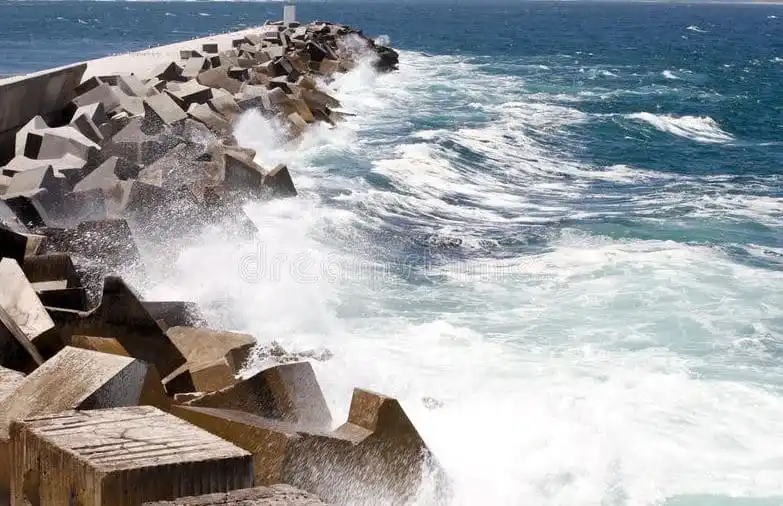The Durability of Concrete in Coastal Areas

You might not know that coastal areas can profoundly shorten the lifespan of concrete structures due to unique environmental stresses. Saltwater exposure, high humidity, and temperature fluctuations aren’t just minor inconveniences; they actively contribute to the corrosion of steel reinforcement and the degradation of concrete itself. These conditions result in cracking and spalling, severely compromising structural integrity if not properly addressed.
By exploring advanced concrete mixes and innovative reinforcement strategies by Lake Macquarie Concreting Solutions, you can discover ways to greatly enhance the durability of concrete in these challenging environments.
Challenges in Coastal Environments
In coastal environments, concrete faces aggressive conditions that greatly impact its durability. You’ll find that the high humidity, frequent rain, and temperature fluctuations can all weaken the structure over time. These factors, combined with wind-driven sand and debris, lead to surface erosion and abrasion. This means the concrete’s outer layers can wear down faster than in inland areas.
Additionally, the air in coastal regions often contains higher levels of carbon dioxide. This can lead to carbonation, a process where CO2 penetrates the concrete and lowers the pH level. When the pH drops, the steel reinforcement bars inside the concrete are more susceptible to rusting. Rust expands and creates internal pressure, which can cause cracks and spalling.
You also need to take into account the impact of biological growth. Coastal areas are conducive to the growth of algae, mold, and other microorganisms that thrive in damp conditions. These organisms mightn’t seem like a big deal, but they can produce acids that gradually break down the concrete’s structure.
Addressing these challenges requires careful selection of materials and protective treatments to enhance the concrete’s resilience in such demanding environments.
Effects of Saltwater Exposure
Saltwater exposure poses a significant threat to the integrity of concrete structures in coastal areas. When saltwater penetrates concrete, it brings with it chloride ions that can lead to the corrosion of steel reinforcement bars. This corrosion expands the steel, causing cracks and spalling in the concrete.
You’ll notice that once these cracks form, they only get worse over time, as more saltwater seeps in and accelerates the damage.
In addition to corrosion, saltwater can also lead to sulfate attack. Sulfates react with the hydrated compounds in concrete, forming expansive products that cause internal stress. This stress leads to cracking, scaling, and eventually, structural failure.
It’s important to understand that even high-quality concrete isn’t entirely immune to these effects; it’s just more resistant.
You can take preventive measures, like using corrosion inhibitors, applying protective coatings, or choosing materials with low permeability. However, regular maintenance is essential.
By inspecting and repairing minor damages promptly, you can extend the life of your concrete structures. Ignoring these risks isn’t an option if you want long-lasting, safe coastal infrastructure.
Saltwater’s effects are relentless, and proactive measures are your best defense.
High Humidity Impact
High humidity exacerbates the degradation of concrete by accelerating moisture absorption and promoting mold growth. When you’re dealing with coastal areas, the combination of high humidity and saltwater creates a perfect storm for concrete deterioration. Moisture penetrates the concrete pores, leading to internal chemical reactions that weaken the structure. Mold and mildew thrive in these conditions, further compromising the integrity of your concrete.
Consider the following factors affected by high humidity:
| Factor | Impact on Concrete | Mitigation Strategies |
| Moisture Absorption | Increases internal pressure | Use sealants |
| Mold Growth | Weakens structural integrity | Regular cleaning |
| Chemical Reactions | Forms harmful compounds | Use corrosion inhibitors |
| Freeze-Thaw Cycles | Causes cracking and spalling | Enhance drainage systems |
You’ll notice that moisture absorption increases internal pressure within the concrete, which can cause cracking over time. Mold growth isn’t just unsightly; it actually weakens the structural integrity. High humidity also accelerates chemical reactions that form harmful compounds within the concrete. Finally, while freeze-thaw cycles aren’t solely a humidity issue, they’re exacerbated by the presence of moisture.
Temperature Fluctuations
Temperature fluctuations pose a considerable threat to concrete durability in coastal areas, often leading to cracking and spalling. When temperatures rise and fall, concrete expands and contracts. This constant movement stresses the material, eventually causing cracks. Once these cracks form, they allow moisture and salts to penetrate deeper into the concrete, exacerbating the damage.
You’ll notice that in coastal areas, the temperature swings can be quite drastic, especially between day and night. During the day, the sun can heat the concrete considerably, causing it to expand. At night, the temperature drops, leading to contraction. This daily cycle of expansion and contraction weakens the concrete over time.
Moreover, seasonal changes add another layer of complexity. In winter, the concrete can freeze and thaw repeatedly. Each freeze-thaw cycle introduces water into the cracks, which then expands when it freezes, widening the cracks further. This repeated action accelerates deterioration and can result in large chunks of concrete spalling off.
To mitigate these issues, you should consider using concrete mixes with low water-cement ratios and additives that enhance flexibility and resistance to temperature changes. Proper curing techniques and protective coatings can also help reduce the impact of temperature fluctuations on concrete structures in coastal areas.
Chemical Reactions in Concrete
Chemical reactions in concrete greatly impact its durability, especially in coastal environments.
When concrete is exposed to seawater, chloride ions from the salt can penetrate the concrete matrix. This process, known as chloride ingress, leads to the corrosion of steel reinforcement. As the steel corrodes, it expands, causing cracks and spalling in the concrete.
Another significant reaction involves the presence of sulfates. Sulfates in seawater or soil can react with the hydrated cement compounds in concrete, forming expansive products like ettringite and gypsum. These compounds cause the concrete to expand and crack, compromising its integrity.
Alkali-silica reaction (ASR) is another chemical phenomenon affecting coastal concrete. In this reaction, alkalis in the cement react with silica in the aggregates, forming a gel that swells when it absorbs water. This swelling creates internal pressure, leading to cracks and further deterioration.
To mitigate these reactions, you should consider using well-designed concrete mixes with low permeability. Incorporate supplementary cementitious materials (SCMs) like fly ash or slag to reduce the concrete’s susceptibility to chloride ingress and ASR.
Also, guarantee proper curing and use corrosion inhibitors to extend the concrete’s life in harsh coastal conditions.
Structural Deterioration
Structural deterioration in coastal concrete often starts with visible signs like cracks and spalling. You’ll notice these early warnings as the harsh marine environment takes its toll. Saltwater, wind, and temperature fluctuations all contribute to the gradual weakening of the concrete structure. Once cracks form, they allow more moisture and salts to infiltrate the material, accelerating the deterioration process.
Consider these common issues associated with structural deterioration:
| Issue | Description |
| Cracking | Initial signs of stress and environmental impact. |
| Spalling | Chunks of concrete breaking away, exposing the inner steel reinforcement. |
| Corrosion | Rust forming on steel reinforcements, expanding and causing further cracks. |
| Efflorescence | White, powdery deposits on the surface indicating moisture ingress. |
These problems, if left unchecked, can lead to significant structural failures. The internal steel reinforcement corrodes when exposed to salt and moisture, leading it to expand and create more cracks. This vicious cycle weakens the concrete even further. Regular inspections and prompt repairs are essential to mitigate these issues. By understanding and identifying these signs early, you can take the necessary steps to prolong the lifespan of coastal concrete structures. Don’t wait until minor issues become major problems.
Protective Coatings and Sealants
When looking to extend the life of concrete structures in coastal areas, applying protective coatings and sealants is a crucial step.
You need to understand that coastal environments are harsh, with saltwater, moisture, and fluctuating temperatures constantly attacking the concrete. Protective coatings act as a barrier, preventing these elements from penetrating the surface and causing damage.
Sealants, on the other hand, fill the tiny pores and cracks in the concrete, reducing the potential for water infiltration and corrosion.
You should choose the right type of coating or sealant based on the specific environmental conditions and the nature of the concrete structure.
Epoxy and polyurethane coatings are popular choices due to their excellent adhesive properties and resistance to chemicals.
Silane and siloxane sealants are also effective as they penetrate deeply into the concrete, providing long-lasting protection.
Advanced Concrete Mixes
Advanced concrete mixes offer a powerful solution for enhancing the durability of structures in coastal environments. When you’re working in areas subjected to harsh marine conditions, selecting the right concrete mix can make a significant difference.
These advanced mixes are engineered to resist the aggressive elements found in coastal zones, such as high humidity, saltwater exposure, and fluctuating temperatures.
One of the key components you should consider is the use of supplementary cementitious materials (SCMs) like fly ash, slag cement, and silica fume. These materials improve the concrete’s resistance to chloride penetration and sulfate attack, which are common issues in coastal areas.
You’ll also find that incorporating fibers, either synthetic or steel, can enhance the mix’s toughness and reduce cracking.
Another important aspect is choosing the right water-to-cement ratio. Lower ratios generally lead to denser, more durable concrete.
Additionally, using high-performance admixtures can further enhance workability, durability, and strength. For instance, corrosion inhibitors specifically designed for marine environments can provide an extra layer of protection.
Reinforcement Strategies
Effective reinforcement strategies are essential for guaranteeing the longevity and structural integrity of concrete structures in coastal areas. You need to focus on corrosion-resistant materials, as the salty environment accelerates deterioration.
Use stainless steel rebar or fiber-reinforced polymer (FRP) bars instead of traditional steel to resist rust and extend the lifespan of your structure.
Additionally, you should apply protective coatings to your rebars. Epoxy coatings act as a barrier against moisture and salt, greatly reducing the risk of corrosion. Galvanizing the steel, by coating it with a layer of zinc, is another effective method. The zinc layer provides sacrificial protection, corroding first and thereby safeguarding the underlying steel.
You’ll also want to guarantee proper concrete cover over the reinforcement. Increasing the thickness of the concrete cover protects the steel from chloride ingress. Follow the recommended standards for your specific project to determine the appropriate cover depth.
Lastly, consider using corrosion inhibitors in your concrete mix. These chemical admixtures can greatly reduce the rate of steel corrosion, contributing to the overall durability of your structure.
Innovative Construction Techniques
Incorporating innovative construction techniques can greatly improve the durability of concrete structures in coastal areas. You can start by using high-performance concrete mixes that include supplementary cementitious materials like fly ash or slag. These materials enhance the concrete’s resistance to chloride penetration and sulfate attacks, key factors in coastal degradation.
Next, you should implement advanced curing methods. Techniques like steam curing or using curing compounds guarantee that the concrete maintains adequate moisture, essential for achieving its intended strength and durability. Don’t overlook the benefits of integrating corrosion inhibitors directly into the concrete mix. These additives form a protective layer on the reinforcing steel, greatly reducing the risk of corrosion.
Consider also using fiber-reinforced concrete. By incorporating materials like polypropylene or steel fibers, you can greatly increase the tensile strength and crack resistance of your structures. Additionally, adopting self-healing concrete technologies can be a game-changer. These concretes contain capsules of materials that activate upon cracking, filling in the gaps and preventing further deterioration.
Lastly, employing smart sensors embedded in the concrete can provide real-time monitoring of structural health. These sensors help you detect early signs of damage, allowing for timely maintenance and extending the lifespan of your coastal concrete structures.
Conclusion
Imagine standing on a windswept shoreline, surrounded by the relentless crash of waves.
To protect concrete structures in these harsh coastal environments, you’ll need to embrace advanced mixes, apply protective coatings, and utilize innovative reinforcement strategies and follow this guide.
With regular maintenance, these resilient structures can withstand saltwater, high humidity, and temperature swings, ensuring they remain steadfast against nature’s fury.
By integrating these techniques, you’re safeguarding the future and strength of coastal concrete marvels.
Read More From Techbullion





